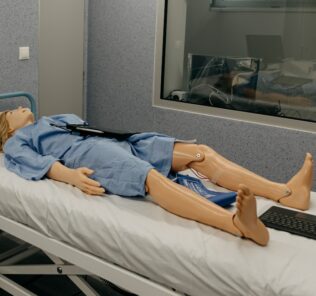Operating Audio / Video Technology for Healthcare Simulation
Running audiovisual (A/V) debriefing systems in healthcare simulation is no easy task! From designing rooms and identifying equipment needs to selecting consulting firms and hardware integrators, and from installation to testing, operation, maintenance, and troubleshooting — the margin for error is high all through the technical process. That being said, the benefits of overcoming these challenges are immense as the unique audio video systems enable clinical simulation programs to show and train learners through reflection of their own real time performance. To help us better understand these complicated technologies, we turn to the new book Comprehensive Healthcare Simulation: Operations, Technology, and Innovative Practice, which is the leading medical simulation book for healthcare professionals starting or expanding their use of the emerging methodology to improve learning, training, and patient safety outcomes. Here we focus on Chapter 11 entitled “The Healthcare Simulation Technology Specialist and Audio/Video Technology” was written by SimGHOSTS Treasurer and Past President Dr. Scott B. Crawford, Associate Professor and Director of the Training and Educational Center for Healthcare Simulation at TTUHSC El Paso, and SimGHOSTS Board Member Todd Dadaleares, CHSOS, Simulation Specialist at Hannaford Center for Safety, Innovation and Simulation.
Editors Note: Next month August 4-7 the annual SimGHOSTS 2020 Healthcare Simulation Technology Conference is going virtual! Join hundreds of Simulation Champions from around the world at this “Global Experience” event! The “Gathering of Healthcare Simulation Technology Specialists” will provide a meeting place for those operating simulation technologies to exchange ideas and network with technical peers as well as receive specialized training in the design, selection and application of healthcare simulation technologies. You will also have opportunities to meet with simulation-based vendors to engage with the latest in healthcare education technology — and all from the comfort of your home or office! Learn more and register here now!
When operating the A/V system for a simulation environment, it is important to know how to adjust the system to meet the needs of educators and facilitators in the space and explain the capabilities of the system to them. Consider every simulation control room, simulation learning space, class- room, computer desktop, auditorium, and off-site environment when deciding what equipment will be needed and where it should be placed. Consistency of equipment and function will minimize the need for learning and decrease the chances for technical errors for both new and existing personnel to efficiently and appropriately use an A/V system. Different simulation spaces may benefit from specific A/V furnishings.
Sponsored Content:
For example, the sight and sound needs for a faculty member reviewing a pre-recorded objective structured clinical examination (OSCE) will be different than the needs of a healthcare simulation technology specialist (HSTS) who is responsible for capturing A/V during a high-fidelity scenario. Furthermore, the technical needs of a skills-based training room will have its own set of media requirements. Planning for the inevitable changes in technology is additionally important as new A/V innovations are being developed and deployed constantly. With so many pieces of specialized gear available to the consumer and professional alike, the choices of equipment and their price ranges are extremely diverse. Understanding the general function and capabilities of each piece of equipment can assist with outlining a plan for eventual upgrades or to enhance function within an existing infrastructure.
Some key questions a simulation design team might ask when planning for or modifying an existing A/V infrastructure include:
- “What must I be able to see and hear during a simulation?”
- “Should the cameras be mounted on the ceiling, on the wall, or on an adjustable stand?”
- “What type of microphones will capture the conversations that take place in a noisy simulation lab?”
- “Do we need discrete control of all video and audio before it is streamed and recorded?”
- “Can I get by using small computer speakers at each standardized patient (SP) station or would headphones be more appropriate?”
Don’t Forget, Audio is Half of “AV”
A simulation space could be thought of as a theater, like a performance area for medical practice-play. The physical surfaces, fixtures, and furniture have sound- reflective tendencies and can soften or harden a listening experience. For example, the height of the ceiling will make a difference in how audio events sound. The higher the ceiling, the more distance the sound has to travel from a participant to ceiling microphones, adding a small but perceivable delay to the signal. This is what makes a room sound large or small. Every microphone has a directional response called a polar pattern. In simple terms, this is the distance in front of and around a microphone that “hears” the sound- making environment. The direction the sound arrives from relative to the polar pat- tern “axis” will determine how well it is detected. Once detected by the “diaphragm” of the microphone, it is converted into an electrical signal and transmitted down a cable usually to a mixer or amplifier. Some microphones pick up sound from all 360° around the axis of the microphone (omnidirectional), while others have a directional response only in front of (or under) the mic’s capsule (metal or plastic protective shielding).
Sponsored Content:
When it comes to high-fidelity audio, you often get what you pay for, whether it be a microphone, mixer, preamplifier, powered speaker, or processor. The better the quality of audio gear, the better the sound quality of the final audio. This does not mean that the highest priced equipment must always be used. Short of full professional gear, adequate quality audio reproduction for the needs of simulation and education can still be obtained, even though it may not be suitable for concert performances at Carnegie Hall. Testing equipment in the space and working with a sound engineer to understand your needs will allow cost-effective infrastructure design choices.
An overhead public address system, commonly known as a PA, might be needed during a scenario for announcing something pertinent to all participants. This separate microphone, amplifier, and speaker system in its simplest form consists of a tabletop condenser microphone connected by a cable to a powered speaker/ amplifier combination that resides in the ceiling. The overhead speaker can dis- tribute key information, like when the scenario concludes or to let participants know that something important or potentially dangerous is about to happen with- out their awareness.
The audio signal collected by a microphone or microphones is usually connected to a device to modify or modulate the signal in some way before it is rebroadcast or recorded. Two primary systems for accomplishing this are commonly available in simulation centers. One is a user-accessible mixer or “mixing board;” the other is a large-scale analog or digital audio signal processing unit that, although configurable, is not designed for frequent user-accessible adjustment and will be located in a server or equipment closet. The microphones in any simulation center will have to be connected by cabling and terminated to some types of audio preamplifier or mixer. The audio mixer or “mixing board” is where the sound from multiple mics or other audio inputs is enhanced, combined together, and output. The output will go either to an amplifier with speakers for the immediate “live” control room mix or to the video encoder to add the audio signal to the video signal from a room for recording or broadcast.
With Video, Quality is An Ever Evolving Headache
A simulation session is often recorded for post-simulation review and some- times saved for the learner’s record. This can assist with debriefing, evaluation, grading, and technical skill review and improvement. Will the recorded event(s) be recorded to VHS tape or DVD? In this day and age probably neither, but it is worthwhile to understand how the final audiovisual signal is output from the recording system, whether the signal is analog or digital, and in what format the file is finalized. If the primary A/V system is analog, meaning it uses analog closed-circuit television (CCTV)-type video cameras connected by coaxial, composite, S-video, or component video cabling, then that final mixed video signal is an analog video signal. Normally, an analog multi-camera system will have a termination point called a multiplexer, or matrix, which will feature several connecting points for camera inputs. It will also have one or more outputs to send a signal(s) to a video monitor. A rack-mounted or tabletop multiplexer organizes the cameras by allowing a user to program them with a camera controller, which also plugs into the multiplexer. With the camera controller in sync, one of the multiple cameras can be selected and then panned, tilted, zoomed, or focused onto a subject using a joystick- style control. In general, the final analog video signal coming from the multiplexer might vary in display resolution, aspect ratio, and refresh rate depending on brands and types of analog systems sending video.
Today, most newly built simulation centers are outfitted with digital video cameras connected through video mixers or multiplexers and output through an encoding service to cat5 (category 5) or cat6 (category 6) ethernet cables to a digital video recording server. Digital video is similar to motion picture film in that it uses encoded digital data (pictures) displayed in rapid succession to achieve the effect of motion. Digital video (DV) has been available commercially since the 1980s and has slowly but surely taken over, replacing analog video to become the medium used throughout the world. There are many different digital video file formats. A DV file is usually made up of two parts: the container and the compressor/decompressor (CODEC). The container denotes what the file type is, for example, .AVI, .MOV, or .MPG. Inside the container there is a CODEC that has the instructional code and settings for how the video and audio are to be decoded and played.
Simulation Learning Management Systems Bring It All Together
A large simulation center might have the following setup: a standardized patient laboratory consisting of ten exam rooms, one hybrid/high-fidelity simulation room, one learner orientation room, one standardized patient-meeting room, one large SP control room, and a hallway between all the exam rooms. If every room has 2 active mics, 1 extra microphone input, and 2 video cameras, that means there are 30 video and 25 audio inputs alone — not to mention power, networking and servers! The individual signals from each room will be transmitted through the system to multiple separated observation stations where any listener, SP, trainer, or faculty member can select any of the ten exam rooms to see and hear via individual video screens and headphones.
A server-based A/V data management system, like those available from Education Management Solutions (SimulationIQ), CAE Healthcare, or WISER, are arguably the most powerful and efficient video delivery and retention system for the modern healthcare simulation center. Many companies produce or design these types of A/V systems (enterprise solutions) or will work to integrate existing pieces of A/V equipment (A/V integrators). There are robust simulation management systems designed for audio and video capture with additional features often offered for grading, scenario cataloging, and inventory and room management components. The specific features may vary from company to company, but functionality is similar for most systems. Institution-wide solutions exist with features that include the ability to record all cameras at once, provide near-instantaneous retrieval of A/V for playback, streaming of live A/V to multiple endpoints (classrooms, debriefing spaces), add annotations that will be embedded into the recorded timeline, and track and evaluate collected learner data.
The Future of AV in Simulation is Already Here
The A/V requirements of a simulation center can differ greatly, depending on what type of educational event is taking place and for which group of learners the event is designed. As the switch from analog-to-digital media continues in earnest, it is still necessary for healthcare simulation technology specialists to know how to use and adapt between the two systems. The availability of high-fidelity audio/visual equipment that delivers excellent image and sound is now ubiquitous. But as any experienced HSTS who works in the field of simulation knows, the best gear is often not the most important factor in running successful simulations. In actuality, it is the knowledge of the interactions of these media elements that matters most.
The prepared HSTS should stay up to date on A/V terminology within the field of simulation as it continues to grow and encompass many electrical, information technology, and theatrical elements. An A/V system that is designed for efficient ease of use and versatility can free up the creativity and improvisational skills necessary for the simulation team to run at the highest standards of execution. A well-designed simulation is a communicative art form, similar to directing a theatrical production. The healthcare simulation technology specialist must be the catalyst for those channels of communication, whether it is fine-tuning the microphone set- tings, converting the video quality to maintain system performance, or making sure the instructions from faculty to clinical actor are clear.
Read the full chapter for a much greater details, examples and case studies — either online or get your copy through the links below
Previously We Shared Chapter Excerpts on:
- Professional Development Opportunities
- Types of Healthcare Simulation
- Medical Simulation Methodologies
- Finding the Right Simulation Personnel
- Curriculum Development, Integration, and Operations
- The Research Process
- Simulation Center Design
- Defining the Role of a Healthcare Simulation Technology Specialist
More Key Take Aways From Latest Simulation Operations Book Include:
- Practical guide helps prepare professionals for the broad scope of simulation in healthcare
- Defines the domains of medical simulation operations
- Focuses on the development of the healthcare simulation technology specialist
- Written and edited by leaders in the field of clinical simulation
Written and edited by leaders in the field, Comprehensive Healthcare Simulation: Operations, Technology, and Innovative Practice is optimized for a variety of learners, including healthcare educators, simulation directors, as well as those looking to pursue a career in simulation operations as healthcare simulation technology specialists. Grab your copy today through our affiliate commissioned links:
Get The Soft Cover Here!
Download the eBook Version Now!
Or Get from Amazon!
Lance Baily, BA, EMT-B, is the Founder / CEO of HealthySimulation.com, which he started in 2010 while serving as the Director of the Nevada System of Higher Education’s Clinical Simulation Center of Las Vegas. Lance also founded SimGHOSTS.org, the world’s only non-profit organization dedicated to supporting professionals operating healthcare simulation technologies. His co-edited Book: “Comprehensive Healthcare Simulation: Operations, Technology, and Innovative Practice” is cited as a key source for professional certification in the industry. Lance’s background also includes serving as a Simulation Technology Specialist for the LA Community College District, EMS fire fighting, Hollywood movie production, rescue diving, and global travel. He and his wife live with their two brilliant daughters and one crazy dachshund in Las Vegas, Nevada.
Sponsored Content:

















